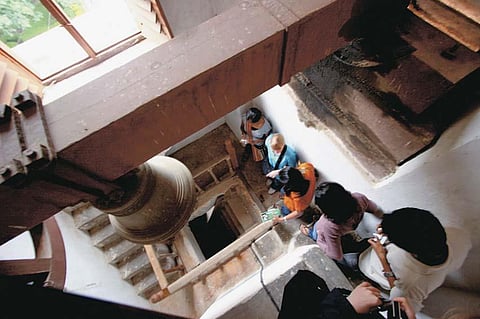
- Destinations
- Experiences
- Stay
- What's new
- Editor’s Picks
- Responsible Tourism
- CampaignsCampaigns
- Subscribe

It&rsquos easy to miss history when it&rsquos staring you in the face. Which is why it&rsquos not hard to believe when Roopa Pai of Bangalore Walks says of the mid-19th century Trinity Church, past which thousands of cars roar each day &ldquoIt&rsquos always open and yet hardly anyone steps in.&rdquo
Trinity Church is a fitting start to the walk because one assumption behind this Victorian Bangalore story is that since 1799 and the routing of Tipu Sultan, Bangalore has been peaceful. The church bears testimony &mdash the names on its walls are of Englishmen who lived in Bangalore but died in action elsewhere or, as per certain plaques, were mauled by tigers in Shimoga or tumbled down Jog Falls. Which is not to say that Bangalore didn&rsquot have its share of casualties. Here again the church stones speak. The &lsquoBM&rsquo carved onto one of the steps stands, Roopa thinks, for &lsquoBenchmark&rsquo, a reference to the famous 19th-century Trigonometrical Survey of India &mdash a gigantic and difficult undertaking that cost many Englishmen their lives.
Roopa tests our knowledge of world history. &ldquoWhat happened in 1789&rdquo &ldquoEr... French... something&rdquo we fumble. &ldquoIn 1776 In 1815&rdquo It turns out that many of the key events of world history are connected to Bangalore. Cornwallis, defeated by George Washington in the American War of Independence, returns to England, then heads, via Calcutta and a Governor-Generalship, to South India to see if he can instead try his hand at quelling a menace called Tipu Sultan. He temporarily succeeds. Louis XVI promises Tipu support but then goes and gets himself guillotined. Richard Wellesley, a later Governor-General, gets his inexperienced younger brother, Arthur, to command a division against Tipu in the 1799 battle that vanquishes the latter. Arthur goes on to become Duke of Wellington and defeat Napoleon at Waterloo.
So no Tipu, no setting up of cantonment Bangalore, no M.G. Road, no walk on this drizzly Sunday morning. And without the French Revolution, would those on the walk who are visitors from Delhi have needed passports to fly south of the Vindhyas Perhaps. The traffic, the hoardings, the glass and chrome of M.G. Road seem lightweight suddenly &mdash they&rsquore all part of the dispensable sets of the theatre of history.
In the event, the British took Mysore, reinstalled the Maharajas, and created the township we are walking through, though only the barest of signs remain. An overgrown plot could be where the bungalow of a certain Winston Churchill once stood. As a young man in the Queen&rsquos Own 4th Hussars Regiment, he spent three leisurely years in Bangalore, reading voraciously, chasing butterflies and, in his own words, devoting himself &ldquo...to the serious purpose of life. This was expressed in one word &mdash Polo.&rdquo
With the British came the Mudaliar businessmen, Persian horse traders, Indian Muslims to supply leather and meat, Christian missionaries, European ladies in search of eligible bachelors. Standing by a slushy pit that has just replaced a colonial bungalow, we sing a Kiplingesque ditty along with Roopa &ldquoI&rsquoll follow my Bangalorey Man, I&rsquoll do the best I can...&rdquo But Bangalore has always been a town of immigrants, she explains. The Vijayanagar chieftain Kempegowda set up base here in 1537, resulting in the creation of a fortified settlement organised around different trades to which settlers from elsewhere were actively invited.
The Walk is a glorious collection of facts and vignettes, cleverly choreographed around leading sights. We&rsquore standing, for instance, in the grounds of the East Parade Church. This was built for Indian regiments, says Roopa, particularly the highly-decorated Madras Sappers. She hands out fuzzy pictures of an American soldier holding a prominently labelled &lsquoBangalore Torpedo&rsquo. &ldquoGuess who&rdquo she asks. I won&rsquot tell, but the point is that the Madras Sappers created this barbed-wire blasting torpedo which has been in regular use since World War I. Who says the expression &lsquoto be Bangalored&rsquo is of recent vintage
Now look across the road, she says. Behind a power grid stands the also-colonial Karnataka Electricity Board building. &ldquoThat building is another reason why the world has been Bangalored. Guess how&rdquo Through yet another fascinating story involving an Irish geologist prospector called Lavelle, the Kolar gold mines, the forward-looking Dewan of Mysore &mdash Sir Visvesvaraya &mdash and the fact that the first light bulb in Asia was switched on in Bangalore in 1905.
Bangalore Walks is the richest live introduction to the city one could hope for. People from all over the world do it, but it&rsquos most likely the Bangalore resident who, labouring under long-term ignorance, experiences the greatest epiphanies. Why is there a statue of a German missionary just off the city&rsquos most famous road Who under the direction of the Maharajas of Mysore systematically greened Bangalore Please sacrifice just one Saturday night party, wake up early on a Sunday, and spend a couple of hours walking with Roopa Pai.
Contact 919845523660, www.bangalorewalks.com
